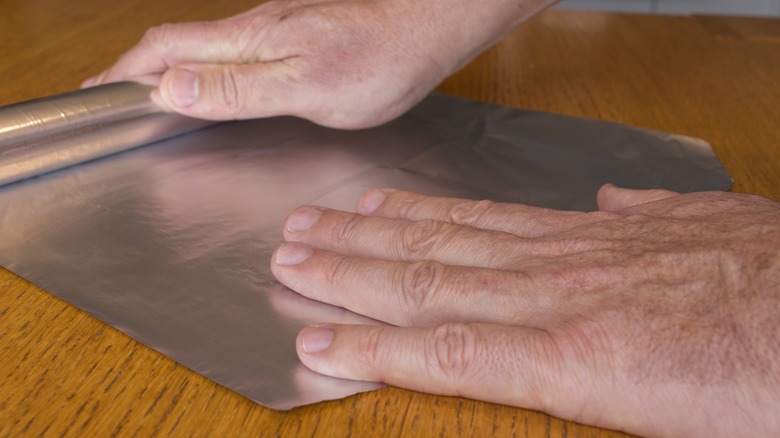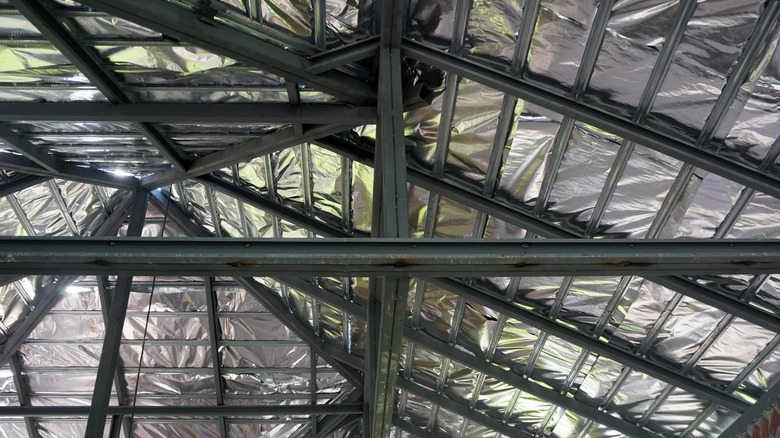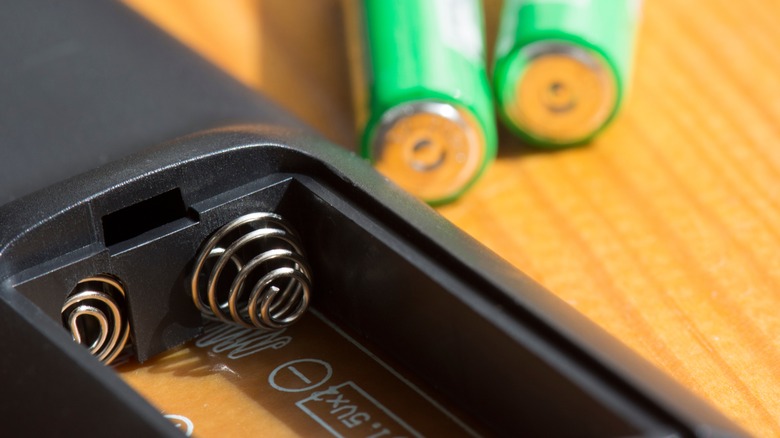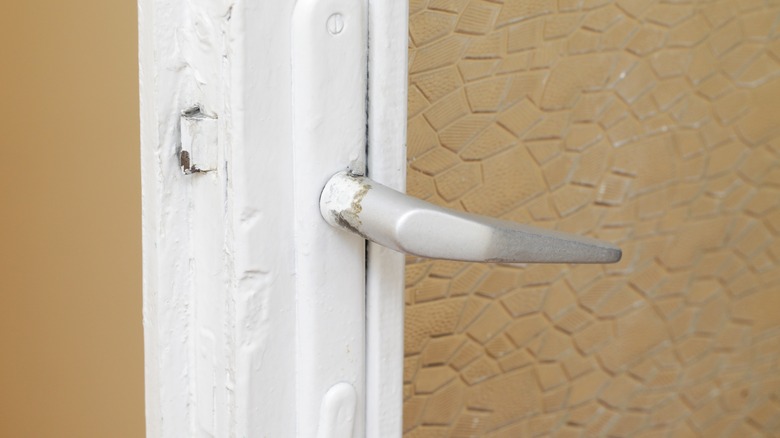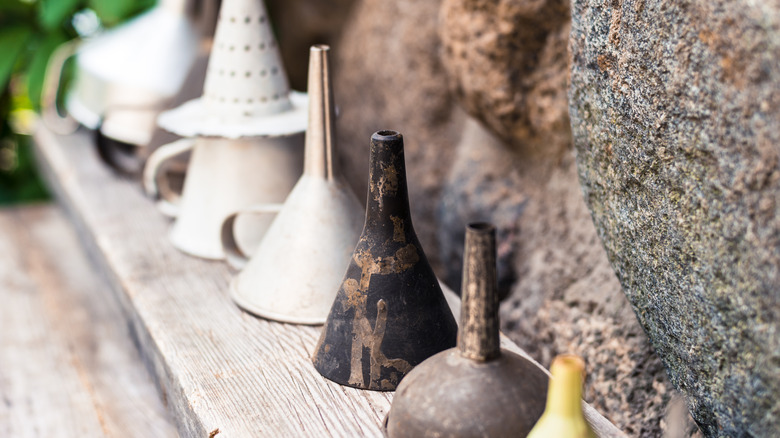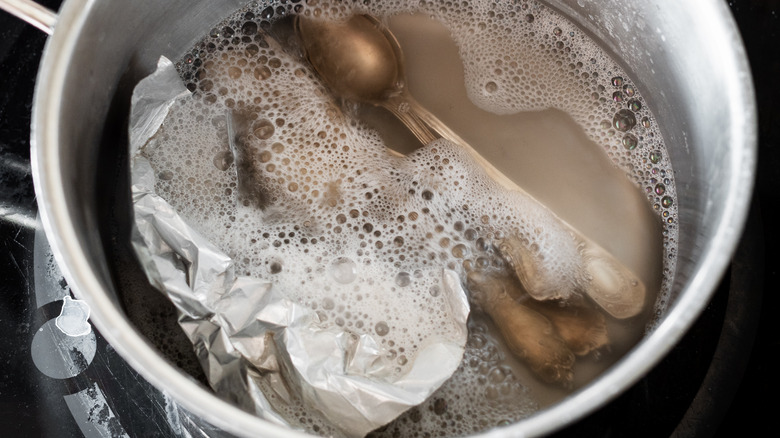Genius Aluminum Foil Hacks For Your Garage
Let's face it — aluminum foil is a little strange, but in a good way. Somewhere in most kitchens there's a roll of the same metal some gutters and engine blocks are made of, rolled so thin that it's stored like parchment paper. It's non-toxic, corrosion resistant, lightweight, reflective, impermeable, odorless, malleable, ductile, and strong. Yet all most of us manage to do with it is keep food warm and prevent stuff from dripping into the bottoms of our stoves. With a little creative thinking, though, you can find many clever ways to use aluminum foil in the garden, craft room, garage, and just about anywhere else.
We can take some clues from the ways that aluminum is already used commercially. You see it lining one or both sides of insulation, formed into temporary containers like roasting pans, integrated into some electrical devices and wiring, attached in big chunks to electronic components to keep them cool, and in a thousand other applications. It's flexible both as a mechanical property and as a description of its utility, and it's one of the few metals you're likely to buy in a basically pure form for multiple purposes. (Try to imagine buying a roll of steel, or having a reason to.) It's cheap because it's easy to produce and is the most abundant metal in the earth's crust. Let's see how we can put it to work where things often get put to work: in your garage or workshop.
Insulate the hotspots in your garage door and walls
Garages, workshops, and storage buildings are notorious for being terrible at maintaining suitable temperatures during hot or cold months because we build them with more thermal breaks and bridges, more gaps in insulation and walls, and doors that offer almost no insulation at all. Some forms of insulation — particularly rolled bubble wrap and poly board — have one or both sides coated with a reflective aluminum finish that's designed to reflect radiant heat. This barrier effect is also why you shouldn't place aluminum foil on the bottom of your oven.
For this hack to work properly — and this bit is important — the reflective surface must face dead air space on at least one side. Gluing aluminum foil to the inside of your garage door would have no impact, but bonding the foil to insulation or adding spacers to create the air gap on the reflective side will improve rejection of heat. Note that reflective insulation must also remain dust-free even when sealed in a wall cavity or its performance will deteriorate over time.
One interesting application of all of this information is YouTuber Digital Friend's idea of using crumpled foil to seal gaps in walls, around pipes, etc. This approach isn't attractive — you'd definitely want to conceal it — but it has a few great advantages. It creates its own air-adjacent spaces. The foil conforms to the area you're sealing. And it's also effective at sealing out pests like insects and rodents.
Make better electrical connections
Pound-for-pound, aluminum is a better electrical conductor than copper, but a little less than two-thirds as conductive by size. Combined with its other attributes like weight and malleability, aluminum is a great solution when you need a conductor and a small size isn't critical. For this reason, it's used in large electrical transmission lines, but we have something different in mind.
You've probably experienced this particular problem before: Over time, batteries stop making a good connection with the terminals in battery compartments, so devices stop working properly and predictably. This issue seems particularly rampant with flashlights and battery-operated toys. If your shop flashlight is showing signs of springs or contacts that have lost their will to connect, you can shim them with aluminum foil with no cost to performance — and very nearly none for the fix.
Execution is simple: Just fold a small piece of foil until it fits in the battery compartment at the end of a battery. You can wedge this bit of aluminum between the terminals and the battery, or within the spring (usually the negative terminal). If the foil pad is thick enough, your problem should be solved. Electricity should move freely through the aluminum shim and produce better contact with the battery. You can also use this trick to substitute triple-A batteries for double-A.
Keep paint where you want it
A substantial portion of the time and money spent on painting projects goes to taping, covering, moving, and otherwise protecting things from adventurous sprays, splats, and splashes of paint. Aluminum foil can help here by virtue of its willingness to form into just about any shape on the fly. Doorknobs are probably the most common item you can protect from paint with aluminum foil. Simply put a piece over the circular head and squeeze it into shape. Allow the foil to overlap the door, then trim away any running out from the edge of the knob base with a razor knife for clean paint lines. You can also use this method to protect cabinet knobs and drawer pulls. But don't use foil to protect the covers of electrical devices like switch plates and receptacles — it can conduct electricity via stray pieces that make contact with an outlet terminal.
The foil fun for painting doesn't stop there. You can also get some mileage out of your aluminum by using it to line roller trays. Or wrap it around brushes to keep them from drying between painting sessions, assuming they're not more than a day or two apart. Or trace a piece of foil the size of your paint can, then drop it on top of the opening when you're taking a break or storing the container. This will keep oxygen from causing an annoying "skin" to form on the paint's surface.
Improvise a funnel
Socks have nothing on funnels (there's your first-time-in-history sentence for the day). Just as socks go mysteriously missing in the laundry, funnels seem to have a corporeal form only when you don't need them. As a result, practically every time you need a funnel you have to buy a new one. Or do you? On a hunch, we discovered, to some amount of surprise, that aluminum foil can be used as a serviceable, temporary replacement for a missing or broken caulking gun. If the stuff can be formed into a piping bag and used to squeeze out really dense, viscous caulks and adhesives, it stands to reason that it can be formed into other shapes useful for moving substances along in an orderly fashion. And that sounds a lot like what a funnel does.
If you ever do see your real funnels again, take note of the wide variety of shapes — particularly of the small ends. They're long, short, wide, and narrow in various combinations, according to their use. Wouldn't it be simpler to make the funnel you need when you need it? You might find this hack so handy that you start making and using funnels where you didn't before, like when filling a salt shaker or olive oil cruet.
Remove rust and tarnish
Don't ask questions. Just wad up some foil, wet it, and rub down your rusty bits. It's particularly effective on chromed parts that are prone to corrosion, as any boat owner can tell you. But you won't have any trouble finding rust in a garage, or any trouble removing it with foil. Speed things up by dipping the foil in white vinegar in place of water. When combined with sodium carbonate (aka baking soda), aluminum can also remove tarnish (another product of oxidation) from silver. Add warm water and scrub the stain away, or simply rough up some foil and drop it, the washing powder, and warm water into a pot with your silverware. Make sure the utensils are touching the aluminum and let the electrolytic magic do its work.
You can, of course, actually ask questions about this process, but you'll get a few conflicting explanations. The simplest is that it's a purely mechanical process by which the aluminum and the protective layer of oxidation on the surface act as abrasives with just the right hardness to deal with rust. Another common explanation has to do with exchanging electrons in some fashion, which causes the rust to turn back into iron, but experts agree that this process isn't possible. Chances are, the foil is simply wearing away the rust, which (unlike oxidized aluminum) is not a protective coating and tends to fall away comparatively easily.
